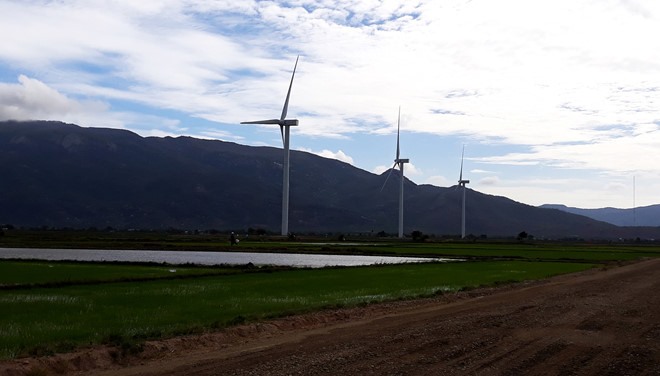|
Ninh Thuận aspires to
be VN’s heart of green energy
NINH THUẬN — With hydropower and fossil fuel potential nearing exhaustion, the development of wind and solar energy is becoming a necessity. 
With hydropower and fossil fuel potential nearing
exhaustion, the development of wind and solar energy is becoming a
necessity.— Photo zing.vn
The coastal
province of Ninh Thuận in south central Việt Nam, blessed with abundant
sunshine and wind, is aspiring to become the country’s centre of renewable
energy and realise its ambitions via robust development policies.
Investment attraction
According to
the province’s green energy plan, by 2030, Ninh Thuận would draw in wind and
solar energy projects with installed capacity of nearly 1,500MW and 3,900MW,
respectively.
Currently,
there are 15 wind energy projects in Ninh Thuận that have got the seal of
approval from the Government and the Ministry of Industry and Trade (MoIT),
12 of which have received investment certificates for a total capacity of
750MW and capital of VNĐ25.6 trillion.
Regarding
solar energy, 25 projects have been approved, 18 of which have received
investment certificates for total capacity of 999MW and registered investment
of VNĐ28 trillion.
In a bid to
attract more renewable energy projects, provincial authorities have been
offering unstinting policies for investors, which usually hit the ‘ceiling
level’ of incentives allowed by the Government to facilitate the completion
of projects.
Specifically,
renewable energy investors would enjoy a waiving of land lease fees for the
entire project’s lifetime, corporate tax exemption for the first four years
and a corporate tax rate of 10 per cent for the next nine years, half the
standard rate. Import tax for procurement of fixed assets in renewable
projects would also be reduced to zero.
Phạm Văn
Hậu, Vice Chairman of Ninh Thuận People’s Committee, said he believed in the
province’s potential to lead the country in developing renewable energy.
“We
prioritise capable and experienced investors who possess hi-tech expertise
and determination to carry out renewable energy projects in the province,”
Hậu said.
In the
future, the provincial People’s Committee would continue to direct its
agencies in working with investors to settle bottlenecks in land clearance
and business procedures.
Wind and
solar energy projects, once they enter commercial production, will bring
“significant contributions” to Việt Nam’s energy security, in tandem with its
role in local socio-development, Hậu added.
The province
has even requested the Ministry of Industry and Trade to review and shorten
the evaluation time for renewable energy projects’ basic design, to allow
investors to soon bring their projects into operation and enjoy the
Government’s preferential policies as set in Decision No.11/2017/QĐ-TTg,
which is the first legal framework to promote solar energy in the country.
Ninh Thuận
has also asked the MoIT to issue national standards on wind energy and solar
energy.
Phạm Đăng
Thành, head of Ninh Thuận’s department of industry and trade, told Vietnam
News Agency that in order to facilitate the process of connecting solar and
wind power plants to the national grid, the province has asked the Government
to pour resources into developing a fully-fledged electricity transmission
infrastructure to prepare for growing demand.
“The
province’s current transmission infrastructure is weak as it was built with
local socio-economic development in mind and not meant to handle the surge of
demand once the many renewable energy projects in the province start
production,” Thành said.
The
province, after working with investors and would-be investors in renewable
energy, has submitted a request to the Government to increase the current
feed-in-tariff for wind energy (7.8 cent/kWh) as well as prolong the
application of solar power feed-in-tariff stated in Decision No.11.
Ongoing projects
Four wind
energy projects have started construction and are expected to go into
operation within the year, including Đầm Nại project in Ninh Hải and Thuận
Bắc districts with installed capacity of 40MW and total investment reaching
over VNĐ1.5 trillion (US$65.78 million). Three turbines of 6MW, as part of
the project’s phase 1, have started running and phase 2 is expected to be
completed in 2018.
Three others
slated to be completed are the VNĐ1.47 trillion Mũi Dinh wind power plant in
Thuận Nam District with capacity of 37.6MW, Trung Nam wind power plant in
Thuận Bắc District with total investment of nearly VNĐ4 trillion and Công Hải
1 plant also in Thuận Bắc District.
Three solar
energy projects have also started construction and are scheduled to deliver
the first batch of green energy this year, namely the Bim plant with capacity
of 30MW and total investment of VNĐ797 billion, the 50MW Bầu Ngứ project with
investment of VNĐ1.15 trillion and the largest solar project in Việt Nam, CMX
Renewable Energy project in Ninh Sơn District with total capacity of 169MW
and investment of VNĐ4.4 trillion.
The CMX
project, undertaken by the CMX Re Sunseap Việt Nam Co Ltd, is expected to be
fully completed and join the national power grid in June next year.
VNS
|
Thứ Năm, 21 tháng 6, 2018
Đăng ký:
Đăng Nhận xét (Atom)
Không có nhận xét nào:
Đăng nhận xét